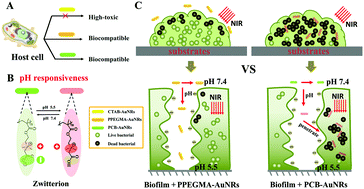Gold nanorods with surface charge-switchable activities for enhanced photothermal killing of bacteria and eradication of biofilm†
Abstract
The increasing growth and severity of bacterial biofilm infections and the appearance of multidrug-resistant bacteria pose alarming threats to public healthcare systems, mainly due to their formidable tolerance to conventional antibiotics. Different from the antibacterial mechanisms of antibiotics, gold nanorods (AuNRs) disinfect microbes by local heating induced by near-infrared (NIR) light irradiation; thus, they are potential disinfection agents. In an attempt to increase the biocompatibility and antibacterial activities of AuNRs against organisms in both planktonic and biofilm phenotypes, polymethacrylate with pendant carboxyl betaine groups was decorated on AuNRs (PCB-AuNRs) to afford AuNRs with pH-induced surface charge-transformable activities. The zwitterion-modified AuNRs demonstrated a pH-responsive transition from negative charge to positive charge; this confers the AuNRs with a change in functionality from biocompatible zwitterionic nanocomposites in healthy tissues (pH = ∼7.4) to enhanced antimicrobial cationic nanocomposites at acidic bacterial infection sites (pH = ∼5.5). AuNRs coated by polymethacrylate with pendant mPEG (PPEGMA-AuNRs) without surface charge transition activities were used for comparison. PCB-AuNRs presented better antimicrobial activity against Gram-negative bacteria (E. coli), Gram-positive bacteria (S. aureus) and their drug-resistant strains (MRSA and EBSL E. coli) than PPEGMA-AuNRs as a result of their pH-responsive surface charge transition activities. Moreover, PCB-AuNRs demonstrated deeper penetration into mature biofilms and better biofilm elimination activities than their non-surface charge-transformable counterparts. The results indicate that the designed zwitterion-coated AuNRs are a promising antibacterial agent for fighting bacterial infections.



 Please wait while we load your content...
Please wait while we load your content...